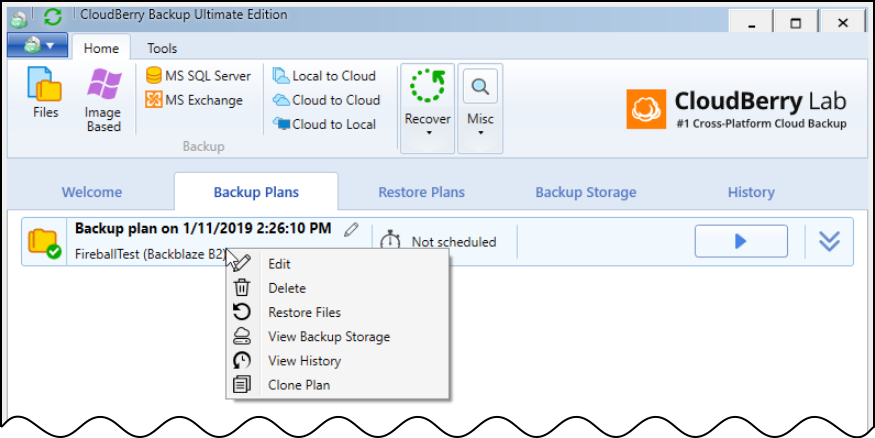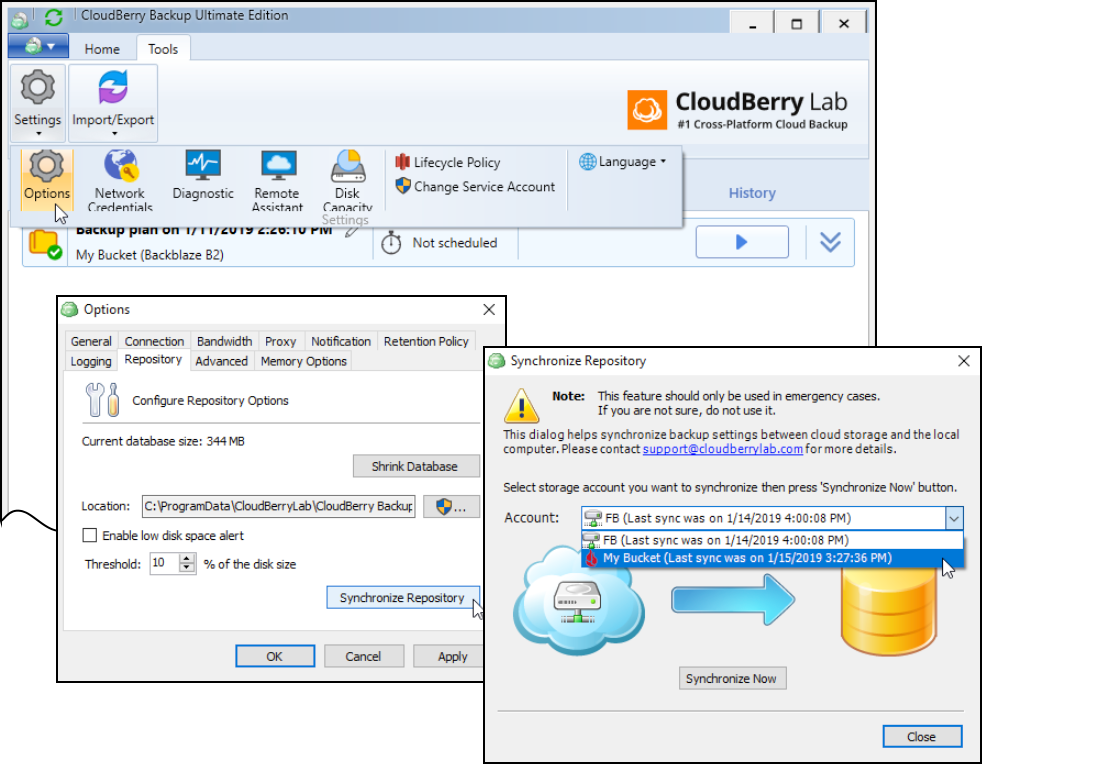- Print
- DarkLight
MSP360 Backup Integration with Backblaze B2 and Fireball Rapid Ingest
- Print
- DarkLight
Starting in version 6.0, MSP360 supports the Backblaze Fireball Rapid Ingest Service. This feature lets you connect your MSP360 backup to files that were uploaded with a Backblaze Fireball without re-uploading them to your Backblaze B2 Cloud Storage bucket.
Enable Backblaze B2
Before you begin: You must have a Backblaze B2 Cloud Storage account. If you already have a Backblaze account and the left navigation menu contains a B2 Cloud Storage section, your account is already enabled for Backblaze B2.
- Sign in to the Backblaze web console.
- In the user menu in the upper-right corner of the page, select My Settings.
- Under Enabled Products, select the checkbox to enable B2 Cloud Storage.
- Review the Terms and Conditions, and click OK to accept them.
Create a Bucket
You can use an existing Backblaze B2 bucket, or you can create a new bucket. You also have the option to create a bucket in the Sync an MSP360 Backup to Backblaze B2 task.
- Sign in to the Backblaze web console.
- In the left navigation menu under B2 Cloud Storage, click Buckets.
- Click Create a Bucket.
- Enter a name for your bucket. Bucket names must be at least six characters and globally unique.
A message is displayed if your bucket name is already in use. - Select a privacy setting: Private or Public.NoteYou can change a bucket's privacy settings at any time.
Files that are in a private bucket require authentication to perform an action, for example, downloading.
Public buckets do not require authentication so you can easily access files. If this is your first time creating a public bucket, complete the following tasks to ensure that you have the correct permissions to create a public bucket:
1. Verify your email address.
2. Have a payment history on file, or use the credit card form to pay a small fee that is credited to your account balance. - If applicable, enable a Backblaze B2 server-side encryption key.
- Enable Object Lock to restrict a file from being modified or deleted for a specified period of time.
- Click Create a Bucket, and copy the value that is in the Endpoint field; you may need this value later.
- Click Lifecycle Settings to control how long to keep the files in your new bucket.
Create an Application Key
You can use your master application key, or you can create a new non-master application key.
- Sign in to the Backblaze web console.
- In the left navigation menu under B2 Cloud Storage, click Application Keys.
- Click Add a New Application Key, and enter an app key name.
You cannot search an app key by this name; therefore, app key names are not required to be globally unique. Key names are limited to 100 characters and can contain letters, numbers, and "-", but not I18N characters, such as é, à, and ü. - Select All or select a specific bucket in the Allow Access to Bucket(s) menu.
- Optionally, select your access type (Read and Write, Read Only, or Write Only).
- Optionally, select Allow List All Bucket Names.
This option is required for the B2 Native API b2_list_buckets and the S3-Compatible API S3 List Buckets operations. - Optionally, enter a file name prefix to restrict application key access only to files with that prefix.
Depending on what you selected in step #4, this limits application key access to files with the specified prefix for all buckets or just the selected bucket. - Optionally, enter a positive integer to limit the time, in seconds, before the application key expires.
The value must be less than 1000 days (in seconds). - Click Create New Key, and note the resulting keyID and applicationKey values.
Create an Initial Backup
You must create your initial backup on the Backblaze Fireball.
- Set up the Backblaze Fireball, and mount the DataForB2 folder by following the steps in this guide so that you can select it as a backup location.
- Add the Backblaze Fireball as the location for your backup plan in MSP360. Click here for the MSP360 guide about how to add network storage as a backup location.
- After the backup completes successfully, pack your Backblaze Fireball in its shipping container and send it back to Backblaze.
Sync an MSP360 Backup to Backblaze B2
Backblaze sends you an email notification when the upload from the Backblaze Fireball is complete. You must change your backup storage from the Backblaze Fireball to your Backblaze B2 bucket, and add your Backblaze B2 account in MSP360.

- Open MSP360 CloudBerry Backup.
- Click
 (cloud backup menu), and select Add New Account.
(cloud backup menu), and select Add New Account. - Select Backblaze B2 as the storage provider.
- Enter your Backblaze B2 account settings.
- Enter a display name.
- If you use your master application key, enter your account ID.
- If you use a non-master application key, enter your application key ID.
- Enter your application key.
- Select an existing bucket, or create a new bucket.
- Click OK.
Connect Backblaze B2 to MSP360

- On the main MSP360 page, right-click your backup plan and select Edit.
- Click Next until you get to the Select Backup Storage page, and select Backblaze B2 as your Backup Storage.
- Click Next until the Finish button appears, and click Finish.
Sync the Repository
You must synchronize the repository to prevent MSP360 from re-uploading data.

- On the main MSP360 page, select Settings and select Options.
- On the Repository tab, click Synchronize Repository.
- In the Account dropdown menu, select your Backblaze B2 bucket.
- Click Synchronize Now.
Forcing resynchronization is not a usual need. - When the sync is complete, click Close to return to the main MSP360 page.
You can now run your backup.
